Victor Moraes1 orcid.org/0000-0001-8683-5719
Willames de Albuquerque
Soares1 orcid.org/0000-0003-3268-7241
Bianca M. Vasconcelos1
orcid.org/0000-0002-5968-9581
Tomi Zlatar1 orcid.org/0000-0002-8915-908X
Béda Barkokébas Junior1 orcid.org/0000-0003-3130-3277
1Escola Politécnica de Pernambuco, Universidade de Pernambuco,
Recife, Brasil,
E-mail do autor principal: Victor Moraes, vik.moraes@gmail.com
Abstract
The
cost of world-wide accidents represent approximately 4% of global Gross
Domestic Product each year, which could be minimized or prevented by using
adequate Personal Protective Equipment (PPE). Although wearing adequate PPE are
mandatory in a number of occupations where workers are exposed to risks,
experience show that supervision is necessary to ensuring it. The traditional
supervision was proved not to be effective enough, making it necessary to turn
on technological solutions. The objective of this work was to investigate if Radio
Frequency Identification (RFID) technology is a feasible solution for monitoring
the usage of PPE on construction sites, giving suggestions which tags to use
and characteristics of RFID portals for field applications. The results of
laboratory tests show that four antennas with correct disposition on the RFID
portal are enough to ensure readability of the worker when passing through it.
While six passive tags were tested, two of them were found to be ideal for this
purpose: the Web Lite Wet Inlay with a rubber wrap due to its protective
characteristics, and the SmartTrac Dog Bone due to its size. In conclusion, the
RFID technology was found to be a feasible solution for automatically control
the wearing of PPE on construction sites. There is a need for further research
on construction sites.
Keywords: Applied Technology; Radio
Frequency Identification (RFID), Occupational Safety and Health; Safety on
Construction Sites.
Resumo
O custo dos
acidentes de trabalho em todo o mundo representa aproximadamente 4% do Produto
Interno Bruto (PIB) global a cada ano, o que pode ser minimizado ou evitado
pelo uso dos Equipamentos de Proteção Individuas (EPI) adequados a atividade
desenvolvida. Embora a utilização dos EPI’s adequados seja obrigatória nas profissões
em que os trabalhadores estão expostos a riscos, a experiência mostra que a
supervisão é necessária para que o uso adequado seja garantido. A supervisão
tradicional demonstrou não ser suficientemente eficaz, tornando necessário o
desenvolvimento de soluções tecnológicas. O objetivo deste trabalho foi
investigar se a tecnologia de Identificação por Radiofrequência (RFID) é uma
solução viável para monitorar o uso de EPIs em canteiros de obras, dando
sugestões de quais tags utilizar e das características dos portais de RFID para
aplicações em campo. Os resultados dos testes de laboratório mostram que quatro
antenas com disposição correta no portal RFID são suficientes para garantir a
legibilidade do trabalhador ao passar por ele. Enquanto seis tags passivas
foram testadas, duas foram consideradas ideais para esse fim: o Web Lite Wet
Inlay com um envoltório de borracha devido às suas características de proteção,
e o SmartTrac Dog Bone devido ao tamanho de sua antena. Em conclusão, a
tecnologia RFID foi considerada uma solução viável para controlar automaticamente
o uso de EPI nos canteiros de obras. Contudo, há necessidade de mais pesquisas
nos canteiros de obras.
Keywords: Applied Technology; Radio
Frequency Identification (RFID), Occupational Safety and Health; Safety on
Construction Sites.
1 Introduction
Occupational
accidents result in more than 2.78 million deaths and 374 million non-fatal
work-related injuries and illnesses each year. According to the estimation from
the International Labour Organization (ILO) [1], the yearly economic cost
correspond to approximately 4% of global Gross Domestic Product each year. The construction
industry is the most influential industry worldwide, representing 21-31% of the
workers fatalities [2], [3]. In this cases, Personal
Protective Equipment (PPE) is the last line of defence to protect the workers from
harm in potential hazardous work situations [4].
The
ILO described working activities of the most common worldwide occupations. This
is commonly used as a base in creation of risk assessments, finally giving
mandatory PPE during each construction phase for all working occupations.
Although
it may seem that providing adequate PPE would resolve the problem, experience shows
that many workers refuse to wear it. This could be attributed to the discomfort
which workers feel while wearing the PPE and to underestimating the risk to
which they are exposed. A study conducted on scaffolders found that workers
failed to anchor their harness not due to poor safety attitude, but to
subjective norms [5]. This means that safety
level on wearing and using PPE is achieved primarily through supervision and
therefore perceived social pressure. However, in practice, traditional
supervision conducted by safety and health professionals seems not to be
effective enough.
On
the other hand, technology proved to be a solution for many of those
effectiveness-based challenges, being able to conduct a work faster and more
accurate.
One
of often used technologies is the Radio Frequency Identification (RFID), which is
using radio waves to identify people or objects, reading information contained
in a wireless device or “tag” from distance without making any physical
contact. Today, the RFID technology can be found in car keys, employee
identification, medical history/billing, highway tool tags and security access
cards [6].
The
RFID technology was found as a possible option for preventing accidents through
detecting near-miss accidents on construction sites. The system was suggested
for managing the access control, environmental condition (including lighting,
vibration, noise) and real-time location of both the workers and
equipment/vehicles [7] as well as supervising
workers unsafe actions [8].
Nevertheless,
although the number of worldwide accidents is increasing, traditional
supervision on wearing PPE has proved to be ineffective, and while there is
technology available for introducing automatic supervision, there is still need
to develop an effective and low cost solution for this purpose.
The
objective of this work was to investigate if it is a feasible solution to apply
RFID technology for monitoring on the usage of PPE on construction sites. Further
on, through investigation on interference and readability, give suggestions on
types of RFID tags and characteristics of RFID portals.
2 Methodology
The
research laboratory tests were conducted in the Occupational Health and Hygiene
Laboratory (LSHT) of the Polytechnic School of Pernambuco (POLI-UPE).
Implementing
a geo-location system using both active and passive RFID technology was found
to be impractical due to high costs of investments in infrastructure, tags,
antennas and readers. Therefore, a more feasible solution was adopted, creating
RFID portals which could be implemented in different zones of the construction
site. Although it wouldn’t be possible to continuously monitor the usage of PPE,
it would allow to automatically-monitor employees whenever they enter or exit
one or more controlled areas. This solution would inform the worker is allowed
to enter the specified controlled area; if not, illustrating to the worker
which additional parameters he should fulfill in order to be suitably prepared
for entering.
Therefore,
tests included the creation of a RFID portal-prototype and the evaluation of
RFID tags assignment, which was analyzed through screening the volunteer who
was passing through the portal by wearing tagged PPE.
2.1 RFID tags
and assignment
The
selection of an adequate RFID tag was determined by the market price, operation
frequency and reading distance. Passive tags were chosen for laboratory tests
due to the best market price, with reading distance from 5 to 10 meters, and
low memory storage, which was not a limitation for the purpose of this study.
In
order to minimize possible interference and ensure proper identification of
tags, six types of passive tags were chosen for laboratory testing. One at a
time, all six tags were placed on each of the selected PPE. The tags were
illustrated in the figure 1.
This
study considered the following 9 PPE: safety helmet; boots (safety, rubber, and
for electric risk); gloves (welding, rubber, pigmented, and for electric risk);
protective glasses; welding face-shield; reflective safety vest; earmuffs; face
shield; fall protective belt.
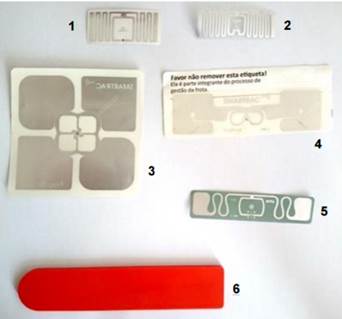
Figure 1: Types of tags considered for
laboratory tests: 1. Tag Laxcen E40; 2. Tag Smartrac Web Lite Wet Inlay; 3. Tag
Smartrac Frog 3D; 4. Tag Smartrac Dog Bone; 5. Etiqueta UPM Belt 292_2; and 6.
Tag AlphaRed (Smartrac Web Lite Wet Inlay with a rubber wrap).
Source: The authors.
2.2 RFID portal prototype
The
worldwide most commonly used walk-through portals are those in function as
metal detectors, present at airports, with dimensions from 72x205 cm to 82x205
cm [9].
For
the purpose of this study it was decided to build a PVC frame with more
comfortable passing dimensions of 100x210 cm, which is illustrated in figure 2.
This would make easier for workers to pass through it, as sometimes they might
be passing with different equipment or materials.
Four
RFID antennas (RFID 1-4) were taped on different parts of the portal in order
to screen all parts of the body where the EPI was installed.
The
selection of an adequate RFID reader was determined by the frequency, reading distance,
functioning and application. It was decided to use ultra-high frequency (UHF)
readers, which were used in another similar previously conducted study [10]. In addition, due to the
reading distance was found to be suitable for the purpose of this study. The
portal consisted of Nesslab RFID reader NL-RF1000 (working with UHF frequency
between 902.75 MHz and 927.25 MHz) and antennas Nesslab model ANT-1200CP of
12.0 dBi, with a beam width of 65°.
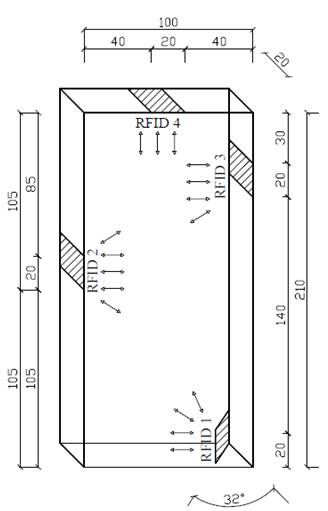
Figure 2: Illustration of the RFID Portal
dimensions (in centimetres).
Source: The authors.
2.3
Data analysis
The
references were searched through the databases by using the institutional IP
address of the University of Pernambuco federate credentials. References were
managed using the Mendeley 1.15.3. Statistical analyses were done by using
excel statistical toolbox. The signal quality was ranging in a scale of 0 to
100%, where 0 was the lowest strength and 100 highest signal quality.
3 Results
The
face-shield with the tag location is illustrated in the figure 3.
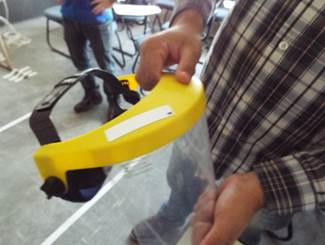
Figure 3: Face shield with the tag.
Source: The authors.
Laboratory
tests with the volunteer wearing different personal protective equipment while
passing through a RFID portal prototype were illustrated in figures 4 and 5.
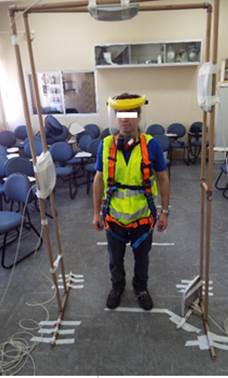
Figure 4: Preliminary laboratory test 1.
Source: The authors.
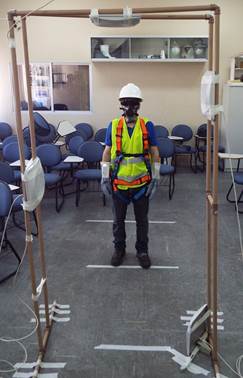
4. Discussion
Two
tags (Web Lite Wet Inlay with or without rubber wrap and Smartrac Dog Bone)
were identified in 100% of passing’s through the portal, and should be
therefore considered for using them in field studies. The Web Lite Wet Inlay
with a rubber wrap tag is well protected with a silicone wrap, and therefore should
be selected for the equipment that is exposed to the influence of different
weather conditions. On the other hand, the SmartTrac Dog Bone has a compact
size, and should be used for all other equipment. The tag Laxcen E40 was not
identified during laboratory tests. This means that quality of the signal is
too weak and should not be used for this purpose.
One
study found that performance of UHF tags and readers might be reduced by a
number of signal interferences, such as noise from machines, older Wi-Fi
systems and devices operating at 916 MHz, by signal bouncing off metal
shelving, rebar in concrete floors or diamond plates, and liquid (for example
human body fluids) [11]. These interferences
should be taken in consideration and solved prior to constructing a RFID portal
as interferences in the communication could difficult readings from passive UHF
tags. For example noise from machines can be resolved by adding some shielding,
such as a sheet of Mylar, around the machine to block the interference. The
Wi-Fi system could be upgraded or by isolating the interrogators from other
signals in the environment. The metal shelving challenge could be often
resolved by repositioning the antennas [11].
The
results from this study show that readers were more effective in identifying
passive tags with larger antenna areas compared with those with smaller. This
fact was potentiated when tags were installed inside gloves and glasses, vests
and protective belt. There the signal quality was lowest, which could be
explained to the interference in UHF readings when the tag is close to the
human body (liquid). Highest signal quality was found in equipment which was
put on greater distance from the human body (like helmet, earmuffs, boots and
shields).
Further
on, it is fundamental to properly fix tags to PPE. The VHB-type of adhesive and
firm acrylic foam tape proved to be efficient for fixing tags on safety
helmets, protective glasses, earmuffs, welding face-shields and face shields. However,
for other types of PPE, such as clothing, boots, gloves, reflective safety
vests, fall protective belts and other fabric equipment, it should be attached
in other ways, such as by stitching it to the equipment. Hereby, it is
important to notice that stitching on PPE should always be done in consultation
with the manufacturer of the PPE, as adding, removing or changing parts might
affect the performance of PPE. For example, sticking a tag on a firefighting
suit using normal sewing cotton may reduce the protective-performance against
fire. Therefore, further studies are needed in order to encounter the most
feasible way to attach tags. Taking in consideration the hostile environment of
construction sites, tags should be protected against physical damage, either by
silicone wrapping, or by other flexible material through which could pass UHF’s
[10].
Laboratory
tests contributed by giving dimensions for building a RFID portal for using in
construction sites (illustrated in figure 2). Four antennas with distribution
as illustrated in figure 2 ensured readability of all equipment when the worker
was passing through it. This is in accordance with a previous similar study [10], which used four antennas
although differently distributed (one screening legs and one screening trump,
distributed on both lateral sides of the portal). The hostile environment of
construction sites demand to additionally cover the basic portal structure
(illustrated in figure 3) with wood and plywood coated in formica. This should
protect the vital parts of the RFID portal from the influence of weather
conditions, from hitting, cutting and tearing, improving the resistance of the
structure and its durability.
Additionally,
the RFID portal could be improved by installing a monitor as an essential part
of the structure. This would benefit through immediate interaction with the
worker, giving him warnings in real time. The portals on construction sites
could be managed in two essential ways: through a network infrastructure or
managed by independent computers installed in each portal present at the
construction site.
An
optimal solution would be to divide construction sites on areas according to
risks to which workers are exposed-to in each one of the areas. It is important
to consider that construction sites have different phases with a dynamic
working environment, therefore with continuous changing of risks present in
each one of the areas. The application of RFID portals would make easier and
more effective updating information on risks and working requirements for each
area and reassuring that the information gets to all of the workers.
Therefore,
RFID portals should be provided on all passages when moving between areas. This
would make the supervision on workers much more effective, assuring that
workers are always properly equipped and with valid PPE.
Additionally,
as all working activities require using of a working suit, it represents ideal
equipment for placing an individual tag. This tag could access the information
recorded inside the company database, giving information on medical and
training attestations for each one of the workers. This would benefit to an
even more effective supervision of workers, assuring proper PPE, medical and
training attestations for all of the workers for working in different areas and
being exposed to different risk-types. Including with monitoring the validity
of each one of screened parameters, the system could remind the worker and
safety professionals to re-validate the medical and training attestations, or
to change the PPE.
It
is necessary to use knowledge and experience gathered from this study in order
to further the research on construction sites. Future studies should
investigate if the RFID technology is a feasible solution in real working
conditions, during different working phases, workers and when using different
PPE. Further on, it is necessary to develop specific software for this purpose.
Finally, the application of RFID technology as a tool for monitoring the usage
of PPE on construction sites could be implemented in combination with other
technological solutions, for example a dynamic construction safety risk
management model [12] or accident occurrence
prediction model [13].
5 Conclusions
The
RFID technology seems to be a feasible solution to automatically control the
wearing of PPE on construction sites. Nevertheless, there is need to conduct
further field research on a number of workers, construction sites, and further
investigate on best ways to secure the RFID portal from different weather conditions,
but taking in consideration not to reduce the readability of the RFID antennas
inside the portal. Further on, there is a need to further investigate the ways to
effectively attach tags on PPE’s without affecting PPE’s quality. Finally, this
technological solution might be implemented with other systems in order to
offer a complete solution from recognition to solving of occupational safety
and health issues.
References
[1] INTERNATIONAL
LABOUR ORGANIZATION (ILO), “Safety and health at work,” 2017. [Online].
Available:
http://www.ilo.org/global/topics/safety-and-health-at-work/lang--en/index.htm.
[Accessed: 30-Nov-2017].
[2] OSHA,
“Construction’s ‘Fatal Four,’” United States Department of Labor. [Online].
Available: https://www.osha.gov/oshstats/commonstats.html. [Accessed:
09-Nov-2017].
[3] Bomel, “Falls
from height - prevention and risk control effectiveness,” HSE Books, vol.
Research R, p. 428, 2003.
[4] Bomel Limited,
“Evidence base for identifying potential failures in the specification , use
and maintenance of PPE at work,” Res. Rep. 419, 2006.
[5] Y. M. Goh, N.
Faddilah, and B. Sa, “Cognitive Factors Influencing Safety Behavior at Height :
A Multimethod Exploratory Study,” J. Constr. Eng. Manag., vol. 141, no.
Witten 2011, pp. 1–8, 2015.
[6] U.S. Deparment
of Homeland Security, “Radio Frequency Identification (RFID): What is it?,”
2017. [Online]. Available:
https://www.dhs.gov/radio-frequency-identification-rfid-what-it. [Accessed:
13-Dec-2017].
[7] W. Wu, H. Yang,
D. A. S. Chew, S. Yang, A. G. F. Gibb, and Q. Li, “Towards an autonomous
real-time tracking system of near-miss accidents on construction sites,” Autom.
Constr., vol. 19, no. 2, pp. 134–141, 2010.
[8] S. Han and S.
Lee, “A vision-based motion capture and recognition framework for
behavior-based safety management,” Autom. Constr., vol. 35, pp. 131–141,
2013.
[9] Passenger
Screening Task Force (Architecture and Technology Workgroup), “Security
Checkpoint Layout Design / Reconfiguration Guide,” Aviat. Secur., 2006.
[10] A. Kelm et al.,
“Mobile passive Radio Frequency Identi fi cation ( RFID ) portal for automated
and rapid control of Personal Protective Equipment ( PPE ) on construction
sites,” Autom. Constr., vol. 36, pp. 38–52, 2013.
[11] M. Roberti,
“What Affects the Performance of UHF RFID Readers?,” RFID Journal, 2014.
[Online]. Available: http://www.rfidjournal.com/blogs/experts/entry?10937.
[Accessed: 15-Dec-2017].
[12] S. Isaac and T.
Edrei, “A statistical model for dynamic safety risk control on construction
sites,” Autom. Constr., vol. 63, pp. 66–78, 2016.
[13] A. J. Tixier,
M. R. Hallowell, B. Rajagopalan, and D. Bowman, “Application of machine
learning to construction injury prediction,” Autom. Constr., vol. 69,
pp. 102–114, 2016.